The global smoke detector market size is calculated at USD 2.29 billion in 2025 and is forecasted to reach around USD 4.78 billion by 2034, accelerating at a CAGR of 8.52% from 2025 to 2034. The North America market size surpassed USD 650 million in 2024 and is expanding at a CAGR of 8.79% during the forecast period. The market sizing and forecasts are revenue-based (USD Million/Billion), with 2024 as the base year.
The global smoke detector market size accounted for USD 2.11 billion in 2024 and is predicted to increase from USD 2.29 billion in 2025 to approximately USD 4.78 billion by 2034, expanding at a CAGR of 8.52% from 2025 to 2034. Growing due to increasing fire safety awareness, stringent government regulations, and smart home advancements.
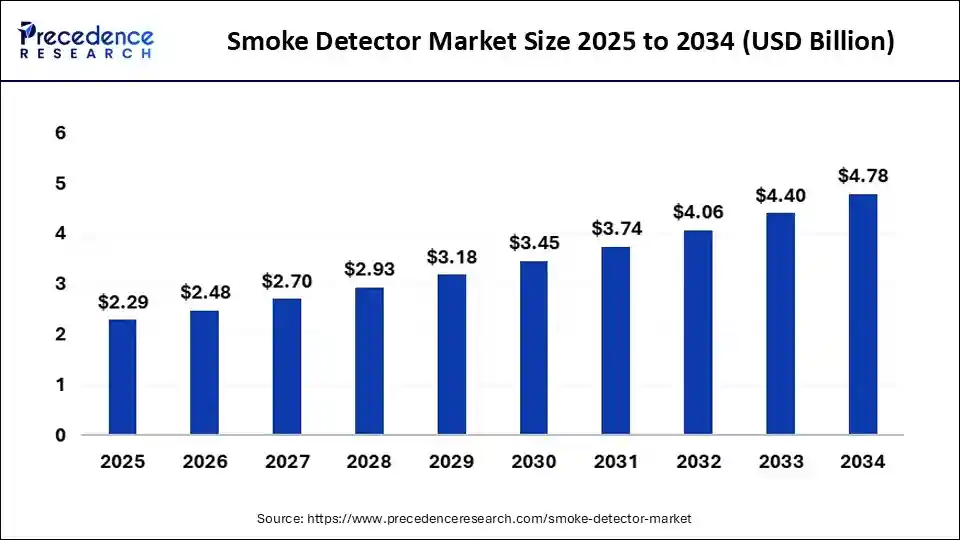
The integration of artificial intelligence (AI) into the smoke detector market has significantly enhanced the efficiency and accuracy of smoke and fire detection. Conventional detectors frequently use basic threshold-based systems, which are vulnerable to false alarms from dust or smoke from cooking. On the other hand, contemporary detectors use sophisticated sensors and machine learning to examine a variety of environmental variables, including temperature variations, smoke patterns, and air quality, before sounding an alarm. By doing this, safety is increased, and emergency responders are only alerted when a real threat exists.
Numerous businesses have already incorporated this cutting-edge technology into their goods. For example, Google Nest Protect greatly reduces needless alarms by using advanced algorithms to distinguish between various types of smoke. In a similar vein, Honeywell has unveiled intelligent fire detection systems for commercial spaces that incorporate predictive analytics to identify possible risks before they become serious. Using multi sensor technology to improve accuracy Bosch is also utilizing intelligent detection solutions in its security systems. These developments are raising the bar for the industry and improving the accuracy and efficiency of fire detection in both residential and commercial settings.
The U.S. smoke detector market size was exhibited at USD 490 million in 2024 and is projected to be worth around USD 530 million by 2034, growing at a CAGR of 8.81% from 2025 to 2034.
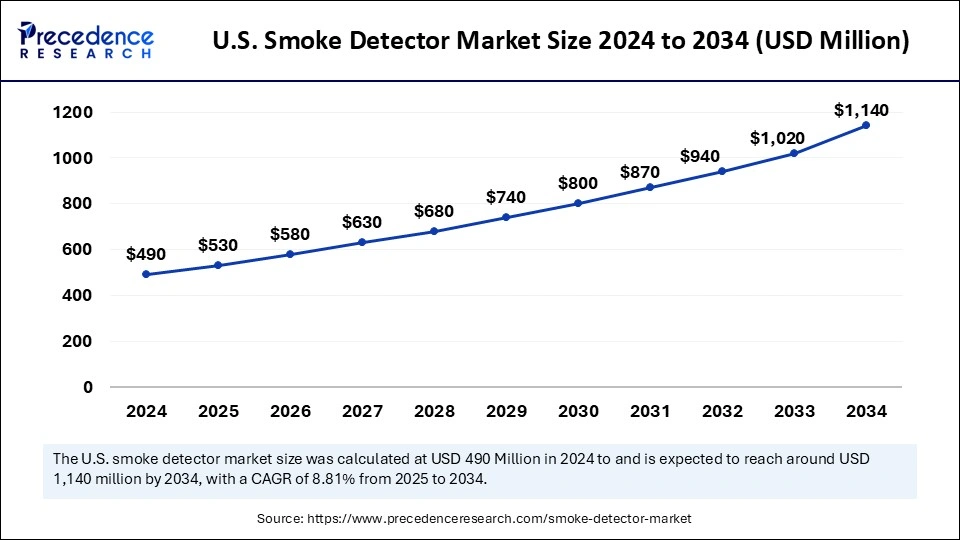
North America dominated the smoke detector market with the largest share due to well-established fire safety regulations and high adoption rates in both residential and commercial sectors. Strict building regulations guarantee steady demand by requiring smoke detectors in all newly built and rented properties. Furthermore, widespread installation and routine replacement of antiquated effective public awareness campaigns have reaffirmed the significance of fire safety.
With a growing preference for smart smoke detectors that are in terraces with home automation systems, the area also benefits from ongoing advancements in fire detection technology. Voice alerts, real-time notifications, and remote monitoring are features that many businesses and homeowners are upgrading to. North America's dominant position is further reinforced by insurance incentives for fire safety compliance, which incentivize property owners to purchase dependable smoke detection systems.
Asia Pacific is expected to grow at the fastest rate in the smoke detector market during the forecast period. Strengthened fire safety regulations, growing infrastructure, and fast urbanization. Smoke detector demand has increased because of several countries' governments enforcing mandatory fire safety measures in high-rise residential buildings, offices, and industrial sites. Growing fire hazard incidents have also raised awareness, which has increased adoption in both residential and commercial properties.
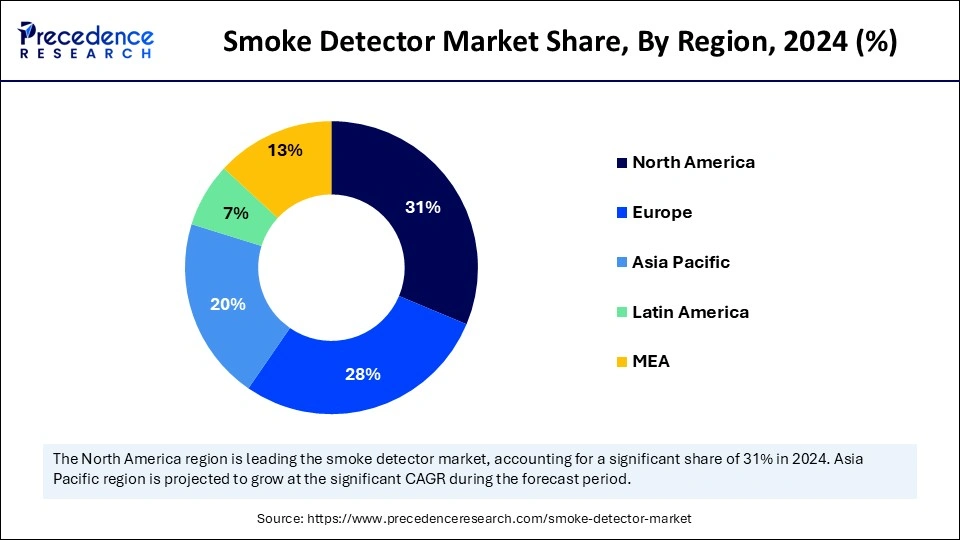
Wireless and networked smoke detectors are becoming more and more popular in the area as smart city projects gain traction. Intelligent fire detection systems that offer real-time tracking and immediate alerts are being installed in many urban areas. Furthermore, as fire detection devices become more affordable, middle-class households and small businesses can now afford them, which is driving market expansion.
Europe is currently experiencing the rapid growth in the smoke detector market due to strict fire safety policies and increasing consumer awareness. The market has grown steadily as a result of laws in many nations mandating smoke detectors in all residential and commercial buildings. Furthermore, government programs encouraging battery-operated and energy-efficient smoke detectors have resulted in their widespread use in homes and offices.
The European market is also being shaped by technological developments in wireless and AI-powered fire detection systems. Alarm systems that are connected and send out synchronized alerts to several rooms are becoming more and more popular. Europe is a major market for innovation in the smoke detector sector because of the region's strong emphasis on sustainability and adherence to environmental regulations, which has further stimulated the development of environmentally friendly fire detection solutions.
The global smoke detector market is experiencing significant growth, driven by increasing awareness of fire safety and strict regulations mandating the installation of fire detection systems in homes, businesses, and industrial facilities. With improvements in wireless connectivity, AI-powered detection, and smart home integration, the industry is changing, and smoke detectors are becoming more effective and user-friendly. Prominent firms such as Honeywell International Inc. Smoke detectors that offer automated emergency responses, remote alerts, and real-time monitoring are leading the way in innovation.
The demand for intelligent smoke detectors with sophisticated sensors and machine learning capabilities is rising in tandem with the speed at which technology is developing. To increase precision and lower false alarms, manufacturers are now creating multi-sensor smoke detectors that integrate photoelectric ionization and heat sensing technologies. Siemens AG and Hochiki Corporation are investing in AI-driven fire detection solutions to enhance safety and reliability, catering to the increasing demand for smarter self-testing and maintenance-free smoke detection systems.
| Report Coverage | Details |
| Market Size by 2034 | USD 4.78 Billion |
| Market Size in 2025 | USD 2.29 Billion |
| Market Size in 2024 | USD 2.11 Billion |
| Market Growth Rate from 2025 to 2034 | CAGR of 8.52% |
| Dominated Region | North America |
| Fastest Growing Market | Asia Pacific |
| Base Year | 2024 |
| Forecast Period | 2025 to 2034 |
| Segments Covered | Technology, End User, and Regions |
| Regions Covered | North America, Europe, Asia-Pacific, Latin America and Middle East & Africa |
Rising fire safety regulations
Installing smoke detectors in residential, commercial, and industrial buildings is now required by law due to stricter fire safety regulations enforced by governments and regulatory agencies around the globe. Stable market growth has been fueled by higher compliance rates brought about by stricter enforcement of fire safety and building codes. These days, building managers and real estate developers view fire detection systems as a necessary investment rather than an extravagance. Ensuring compliance with these regulations is also being facilitated by the introduction of intelligent compliance monitoring solutions.
Increasing fire incident
The increase in incidents involving fire in commercial, industrial, and residential settings has raised awareness of fire safety precautions. The adoption of smoke detectors is growing as a preventative safety measure to lessen risks to life, property damage, and business interruptions. Governments and non-governmental organizations are starting fire safety campaigns that highlight the significance of early fire detection. Businesses are increasingly being compelled to invest in sophisticated fire detection and suppression systems due to the monetary losses incurred by fire disasters in commercial buildings.
Governments and NGOs are launching fire safety campaigns emphasizing proactive fire prevention. High-precision fire safety equipment is being integrated by businesses in an effort to reduce financial losses. With its photoelectric sensing technology and round-the-clock monitoring, AAA Smart Home Security provides smart smoke detectors that improve fire safety efforts by notifying homeowners via smartphone.
Frequently false alarms leading to consumer frustration
One of the biggest challenges in the smoke detector market is false alarms, which frequently result in irrational emergency reactions and user frustration. Many conventional smoke detectors, particularly those that use ionization, are extremely sensitive to dust building up from bathrooms and cooking fumes, setting off false alarms even in the absence of a true fire hazard. Fire safety is seriously jeopardized since many users disable or remove their smoke detectors due to this inconvenience.
Siemens has unveiled AI-enhanced smoke detection technology that reduces false alarms by using intelligent pattern recognition to distinguish between non-hazardous smoke and actual fire threats. Customer complaints and a decline in confidence in fire safety systems result from the continued production of traditional ionization smoke detectors by numerous older brands, such as Kidde and BRK Electronics, which are still prone to false alarms.
Advancements in detection technology
New innovations in sensor technology, AI-powered fire detection, and machine learning algorithms are significantly improving the accuracy and reliability of products of the smoke detector market. Steam cooking fumes or dust can cause false alarms with traditional detectors, frustrating users and making them turn the devices off. Dual sensor technology (photoelectric + ionization) and heat detection are now used by sophisticated detectors to distinguish between dangerous and innocuous smoke sources.
Integration with professional monitoring services
Traditional smoke detectors used to sound an audible alarm, but these days, they are being connected to professional monitoring services that are available around the clock to guarantee that fire emergencies are responded to right away, even if the homeowner is not home. By informing residents and emergency personnel, these services shorten response times, minimize property damage, and reduce the possibility of casualties. This change increases the use of smoke detectors by integrating them into a wider ecosystem for fire safety and security.
The photoelectric segment held the dominating share of the smoke detector market in 2024 due to their efficiency in detecting smoldering fires, which are common in homes, offices, and hotels. Photoelectric detectors are preferred over ionization models by governments and regulatory agencies worldwide because they use a light beam to sense smoke particles. In contrast, ionization detectors react quickly to flaming fires, making them more effective at detecting slow-burning fires caused by electrical malfunctions or unattended cigarettes. Photoelectric detectors also demonstrate superior performance in both residential and commercial settings and have lower false alarm rates.
Underwriters Laboratories and the National Fire Protection Association, for instance, support the increased use of photoelectric technology in homes. In this market, major players like Siemens AG, Honeywell International, and Kidde are well-represented and provide cutting-edge photoelectric smoke detection systems with clever connectivity features.
The dual sensor segment is expected to grow at the fastest rate in the market during the forecast period. These detectors are appropriate for both smoldering and fast-flaming fires because of their extensive fire detection capabilities. In large residential complexes, commercial spaces, and mixed-use buildings where various fire hazards exist, this adaptability is especially crucial. The adoption of dual sensor detectors has also increased due to the growing need for intelligent and networked fire detection systems.
Businesses such as first alert BRK Brands and X-Sense are making investments in Internet of Things enabled dual sensors smoke detectors that provide real time notifications to smart phones guaranteeing prompt emergency response times, the expansion of this market is also being accelerated by government programs that support higher fire safety standards in both public and private infrastructures.
The industrial segment held the dominating share of the smoke detector market in 2024 because manufacturing facilities, power plants, chemical factories, and warehouses are at a high risk of experiencing fires. Fire safety is a primary concern because industrial fires can cause significant financial losses, environmental risks, and fatalities. Installing cutting-edge fire detection systems in industrial facilities is required by strict government regulations and workplace safety standards such as those established by the NFPA (National Fire Protection Association) and OSHA (Occupational Safety and Health Administration).
To provide early warning in high-risk situations, industrial smoke detectors frequently integrate with larger fire alarm and suppression systems utilizing technologies such as aspirating smoke detection. Leading firms in this field, including Honeywell, Johnson Controls, and Siemens, offer industrial-grade smoke detection systems designed for dangerous settings. Furthermore, there is a growing need for strong fire safety systems in factories and production facilities due to the growth of industrial infrastructure, particularly in developing nations like China and India.
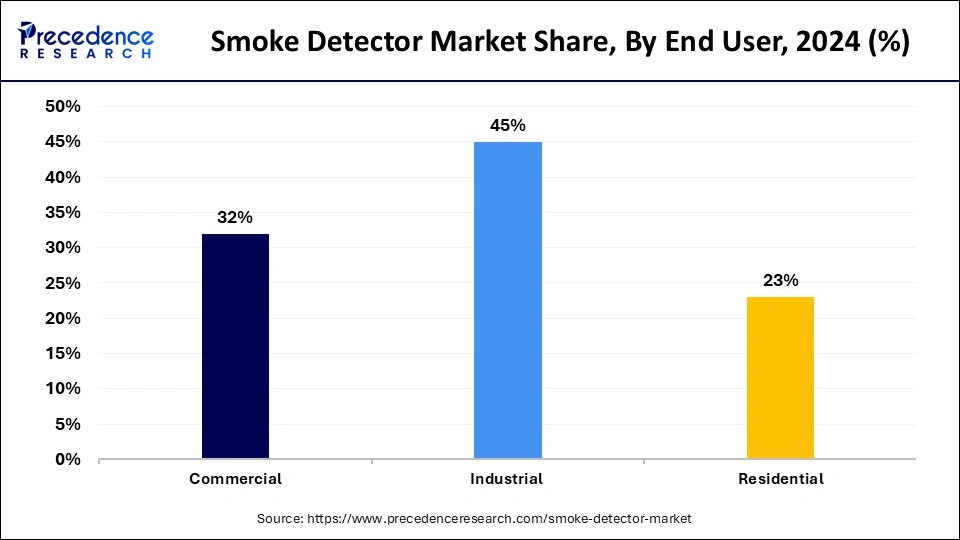
The residential segment is expected to grow at the fastest rate in the market during the forecast period, driven by rising awareness about fire safety, increasing home automation trends, and supportive government initiatives. Governments around the world have put laws into place mandating smoke detectors in newly built homes and rental properties. States such as California and New York, for instance, have stringent regulations requiring smoke alarms to be installed in every residential unit.
Smart smoke detectors are becoming more common in modern homes. These detectors connect to home automation systems and send alerts straight to the homeowner's smartphone. Companies like Kidde Ring (owned by Amazon) and Nest (a Google subsidiary) are spearheading this change with cutting-edge Wi-Fi-enabled smoked detectors that provide voice alerts and real-time monitoring. The residential segment is the one with the fastest rate of growth for smoke detectors as rising urbanization and rising disposable income levels encourage homeowners to purchase high-quality smoke detection systems.
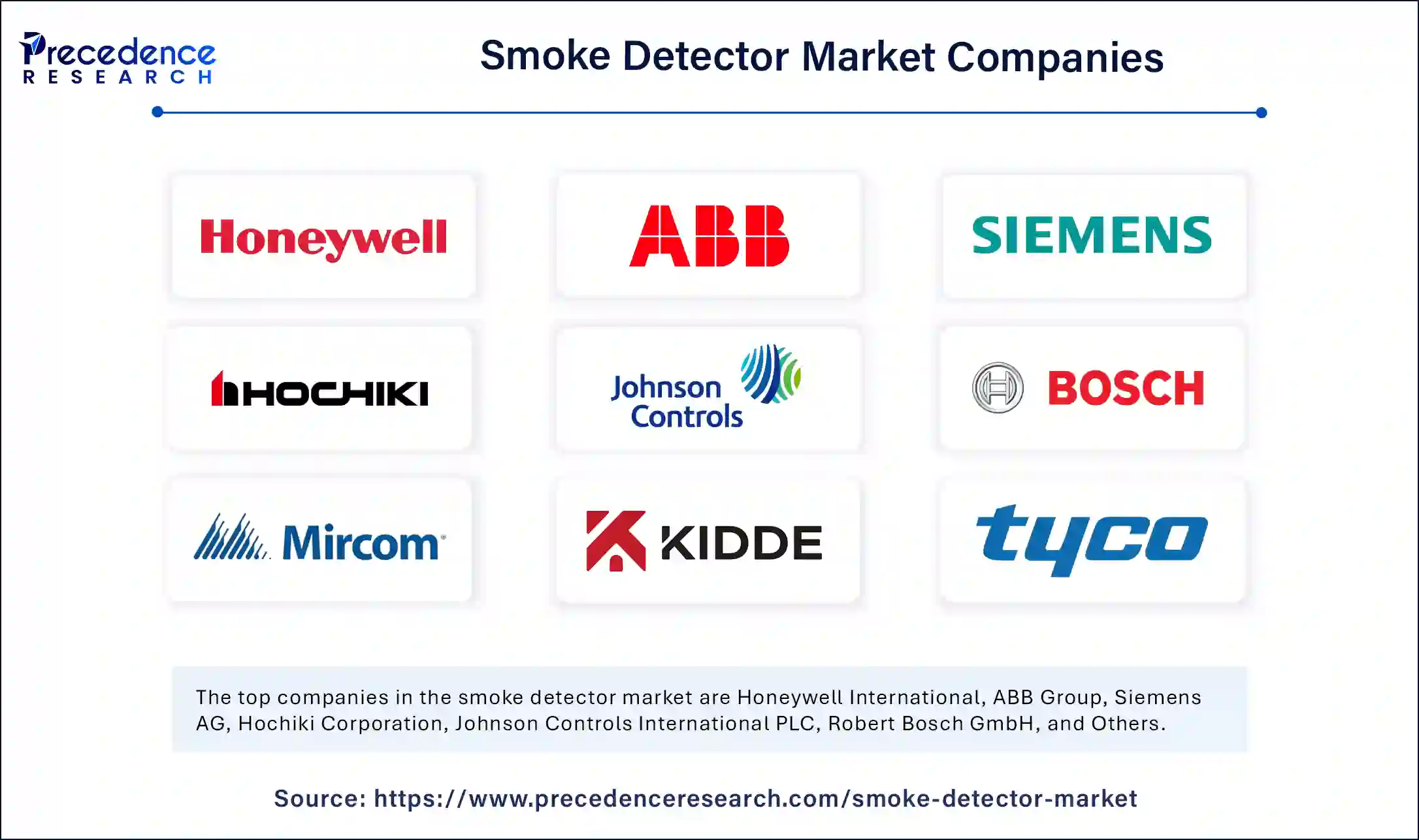
By Technology
By End User
By Geography
For inquiries regarding discounts, bulk purchases, or customization requests, please contact us at sales@precedenceresearch.com
No cookie-cutter, only authentic analysis – take the 1st step to become a Precedence Research client